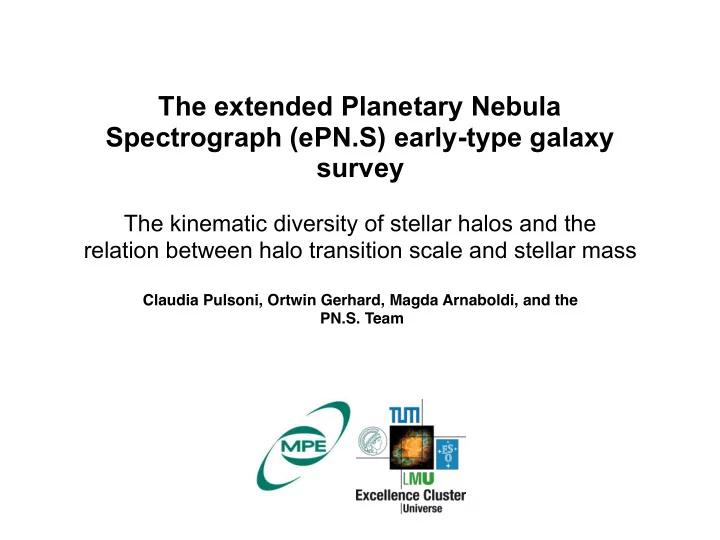

The extended Planetary Nebula Spectrograph (ePN.S) early-type galaxy survey The kinematic diversity of stellar halos and the relation between halo transition scale and stellar mass Claudia Pulsoni, Ortwin Gerhard, Magda Arnaboldi, and the PN.S. Team
The extended Planetary Nebula Spectrograph (ePN.S) early-type galaxy survey P.I. M. Arnaboldi M. Capaccioli - A. Chies-Santos - L. Coccato - A. Cortesi - K. Freeman - O. Gerhard - J. Hartke - K. Kuijken - A. Longobardi - M. Merrifield - N. R. Napolitano - C. Pulsoni - A. Romanowsky - C. Tortora - E. Moylan - C. Narayan Arnaboldi+2018, in prep. • 33 early type galaxies with a wide range of structural parameters (luminosity, central velocity dispersion, ellipticity, boxy/diskyness) • 24 fast and 9 slow rotators • nearby, distance < 25 Mpc 10 10.4 < M * /M ⊙ < 10 11.7 The PN.S at the William • Magnitude limited sample, Herschel Telescope, La • 80-700 PNs per galaxy • Kinematics out to [3 - 13 Re], median 5.6 Re Pulsoni et al. 2017arXiv171205833P
R / Re R / Re Weijmans+2009 σ [km/s] σ [km/s] Statler+1999 Foster+2016 PA kin − PA phot [deg] V rot [km/s] PA kin − PA phot [deg] V rot [km/s] Emsellem+2004 Foster+2016 <V> [km/s] <V> [km/s] Foster+2016 SLOW ROTATOR FAST ROTATOR Pulsoni et al. 2017, 2017arXiv171205833P ETGs Kinematics
Halo Vs Central Kinematics • SLOW ROTATORS onset of rotation in the halo • FAST ROTATORS -70% with slowly rotating outer spheroid -30% rapidly rotating at large radii (extended disk component or rapidly rotating outer spheroid) -40% triaxial fast rotators consistent with presence of photometric twist Pulsoni et al. 2017arXiv171205833P
Kinematic Transition Radius • The kinematic transition from central regions to halos of ETGs correlates inversely with mass • R T marks the transition between the inner regions, dominated by the in- situ stellar component, and the halo, which is mostly accreted Pulsoni et al. 2017arXiv171205833P
Recommend
More recommend